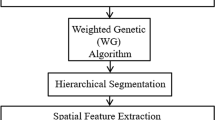Abstract
The Satellite image classification is a complex process. It gives the information about the land cover and thematic land use in remotely sensed data. Image classification is the one of the important application of remote sensing. It is the process of obtaining details about the objects without physical contact. The main objective of image classification is to classify various objects or classes in satellite images. This paper gives an automatic method for the hyper spectral image classification and it classifies the images into multiple land cover objects. The proposed method assigns each pixel in the image to a group of pixels based on reflectance. In this work the acquired input satellite image is preprocessed and then applied classification methods. The proposed classification method includes both spectral and spatial information. In this paper the proposed method uses K-Means clustering algorithm for segmentation and Artificial Bee Colony optimization algorithm is used for classification. The existing method is Particle Swarm Optimization. Both the methods are compared in terms of sensitivity, specificity, overall accuracy and kappa coefficient. The Proposed method has better statistical values compared to the proposed method. This work is simulated in MATLAB R2017b version with system configuration of i3 processor and 8 GB.
Access this chapter
Tax calculation will be finalised at checkout
Purchases are for personal use only
Similar content being viewed by others
References
Thakur N et al (2017) A review on image classification techniques. Int Res J Eng Technol (IRJET) 1588–1591
Menaka D et al (2014) Land cover classification of multispectral satellite images using QDA classifier. In: International conference on control, instrumentation communication and computational technologies (ICCICCT), pp 1383–1387
Senthilnath J, Omkar SN, Mani V, Karnwal N, Shreyas PB (2013) Crop stage classificat ion of hyperspectral data using unsupervised techniques. IEEE J Sel Top Appl Earth Observ Rem Sens 6(2) (2013); Smith TF, Waterman MS (1981) Identification of common molecular subsequences. J Mol Biol 147:195–197. doi:10.1016/0022-2836(81)90087-5
Omkar SN, Sivaranjini V, Senthilnath J, Suman M (2010) Dimensionality reduction and classification of hyperspectral data. Int J Aerosp Innov 2(3):157–163
David L (2002) Hyper spectral image data analysis as high dimensional signal processing problem. IEEE
Richards JA, Cluster-space representation for hyper spectral data classification. IEEE J Sel Top Geosci Rem Sens Lett 16
Imran M, Jabeen H, Ahmad M, Ababs Q, Bangyal W, Ababs Q, Opposition based PSO and mutation operators(OPSO with power mutation) In: 2nd International conference on education technology and computer, Shanghai, p V4-506–508
Pant M, Thangaraj R, Singh VP, Abraham A (2008) Particle swarm optimization using sobol mutation. In: First international conference on emerging trends in engineering and technology, Nagpur, Maharashtra, pp 367–372
Imran M et al (2012) An overview of particle swarm optimization variants. In: Malayasian technical universities conference on engineering & technology
Alam S et al (2014) Research on particle swarm optimization based clustering: a systematic review of literature and techniques. Elsevier
Holland JH (1975) Adaptation in natural and artificial systems. The University of Michigan Press
Dorigo M (1992) Optimization, learning and natural algorithms. Ph. D. Thesis
Kennedy J, Eberhart R (1995) Particle swarm optimization. In Proceedings IEEE International Conference on Neural Networks, vol 4, pp 1942–1948
Kennedy J, Eberhart R (1995) Particle swarm optimization. In: Proceedings IEEE International Conference on Neural Networks, vol 4, pp 1942–1948
Abu-Mouti FS et al (2012) Overview of artificial bee colony (ABC) algorithm and its applications. IEEE
Karaboga D (2005) An idea based on honey bee swarm for numerical optimization. Erciyes University, Engineering Faculty, Computer Engineering Department, Tech Rep TR06, pp 1–10
Yang XS (2008) Nature-inspired metaheuristic algorithms. Luniver Press, London
Acknowledgements
The First author express sincere thanks to JNTUA, Anantapuramu, Andhra Pradesh, where he is a research scholar and AITS, Rajampet, A. P. for providing good research facilities.
Author information
Authors and Affiliations
Corresponding author
Editor information
Editors and Affiliations
Rights and permissions
Copyright information
© 2020 Springer Nature Singapore Pte Ltd.
About this chapter
Cite this chapter
Venkata Dasu, M., Reddy, P.V.N., Chandra Mohan Reddy, S. (2020). Classification of Remote Sensing Images Based on K-Means Clustering and Artificial Bee Colony Optimization. In: Gunjan, V., Senatore, S., Kumar, A., Gao, XZ., Merugu, S. (eds) Advances in Cybernetics, Cognition, and Machine Learning for Communication Technologies. Lecture Notes in Electrical Engineering, vol 643. Springer, Singapore. https://doi.org/10.1007/978-981-15-3125-5_7
Download citation
DOI: https://doi.org/10.1007/978-981-15-3125-5_7
Published:
Publisher Name: Springer, Singapore
Print ISBN: 978-981-15-3124-8
Online ISBN: 978-981-15-3125-5
eBook Packages: Intelligent Technologies and RoboticsIntelligent Technologies and Robotics (R0)




